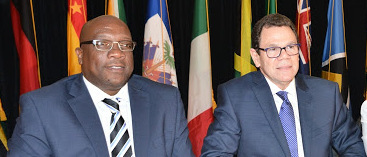CDB Lauds Economic Performance of St.Kitts-Nevis as he announces a 4.1 per cent Target growth rate for the Caribbean
Get our headlines on WHATSAPP: 1) Save +1 (869) 665-9125 to your contact list. 2) Send a WhatsApp message to that number so we can add you 3) Send your news, photos/videos to times.caribbean@gmail.com
 St.Kitts-Nevis PM Dr.Hom. Timothy Harris and Wrren Smith
St.Kitts-Nevis PM Dr.Hom. Timothy Harris and Wrren Smith
BRIDGETOWN, Barbados — Lamenting the fact that borrowing member countries (BMCs) were only able to achieve just about an average of one per cent growth in 2019, president of the Caribbean Development Bank (CDB) Dr Wm Warren Smith says the task for the institution he leads remains the empowerment of the countries of the region so that economic growth and the improvement of the quality of life for citizens becomes the constant.
Speaking at the CDB’s annual news conference in Jamaica , Smith said: “We’re projecting 4.1 per cent growth for the region for 2020,” explaining that the prediction was premised on expected global activity for the year.
He added that a slowdown in growth experienced in 2019, from an average of 1.6 per cent the previous year, was in tandem with relatively sluggish global growth of 2.9 per cent, as well as mixed signals from the international economic environment.
Smith said the fastest-growing economies of the region for 2019 were Anguilla and Dominica, at 10.9 per cent and 5.7 per cent, respectively.
Tourism performance, he explained, improved in almost every BMC of the CDB and highlighted that visitor arrivals grew by double digits in St Kitts & Nevis and the Cayman Islands. He also pointed out that, while Abaco and Grand Bahama Islands faced challenges in the wake of Hurricane Dorian in September last year, “The Bahamas recorded the highest number of visitor arrivals… and increased airlift from North America.
St.Kitts-Nevis has moved to the head of the class in Cruise Tourism in the OECS with 2 straight years of million plus visitors and the highest average visitor spend in the subregion. Put another way only three countries in the Caribbean has a higher average visitor spend than St.Kitts-Nevis and the twin island federation leads the OECS.
In his comprehensive review, Dr Smith indicated that economic growth remained flat in Trinidad and Tobago, “pointing to subdued activity in energy, manufacturing and construction”. He added that delays in the commencement of various private sector projects, particularly in tourism, contributed to a slight contraction in the Barbadian economy.
Still, he had praises for the implementation of the Barbados Economic Recovery and Transformation (BERT) Programme, adding that the resultant strengthened fiscal framework led to a primary surplus of six per cent of gross domestic product (GDP) in 2019. The Barbados debt ratio, he continued, dropped to under 120 per cent of GDP, from approximately 127 per cent in 2018, along with an improved credit rating consequent to the restructuring of the country’s external commercial debt.
Smith said the debt-to-GDP ratio fell in 10 borrowing member countries, among them Barbados, Grenada, Jamaica, and St Kitts and Nevis. This, he said, was encouraging, and explained that, “These BMCs are at various stages of implementing home-grown fiscal reform programmes.”
Grenada reported an increased fiscal surplus after the implementation of a new tax administration Act, which resulted in increased tax revenue, as well as its debt ratio fell below the international benchmark of 60 per cent of GDP.
St Kitts and Nevis reported a very laudable debt ratio below 60 per cent, which was attributable to a fiscal surplus.
With 2020 being the golden anniversary year of the bank, Smith said the CDB “remains resolute in our commitment to assist the BMCs to meet the [UN] sustainable development goals by 2030” and posited that there are key milestones to be achieved within the decade to attain the projected growth targets.
Leave a comment
You must be logged in to post a comment.